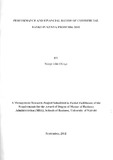| dc.description.abstract | The objective of this study is to identify factors, in a ratio form that shape bank
performance as measured through return on assets (ROA) and return on equity (ROE). To
predict performance, selected indicators are used. The predictor variables include
liquidity, credit risk, capital adequacy, size and macroeconomic variables that included
GDP, interest rate and inflation. The population for this study comprises all commercial
banks in Kenya, 49 licensed commercial banks in Kenya as of 31st. December 2010; and
the data for the period between 2006 and 2010.
Regression analysis was used to test the relationships. The findings are that liquidity,
capital adequacy and the size of the bank explained variations in performance over the
period of study. Furthermore, large banks earn superior returns compared to small banks.
As liquidity decreases in large (size) banks there is improvement in performance
improves. This suggests that bank size is desirable and that size could act as a buffer for
liquidity risk. Additionally large banks with adequate capital post superior return on
assets.
In conclusion, some banks in Kenya appear to be earning much higher returns than their
counterparts despite being in same macroeconomic environment. There is therefore a
need to study and explain variations in both ROA and ROE. In addition, large banks
earnings are higher than that of small banks. The implication is that small banks should
merge. In terms of capital adequacy, the Central Bank of Kenya should reset the levels to
impact positively on bank performance. Finally, low correlations between the ratios used
in this study and profitability suggest monopoly in the banking industry, i.e. a market
where banks are too powerful and thus take advantage of their customers. Therefore,
regulators should develop market power to discipline errant banks. In fact, given the
public complaints about the commercial banks and in light of the findings in this study
that there is no visible modeling of profitability within the banks there is a need to
reorganize the banking sector. | en |

